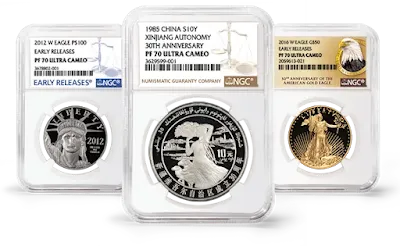The state of preservation of a coin is one of the most important factors in determining its value, alongside its historical significance and the number of specimens issued. It is common for beginners to have difficulty evaluating their coins, as there is a significant difference between a piece with impeccable minting and another identical in all aspects but showing circulation marks. This distinction is not always noticeable to untrained eyes in numismatics. We can say that the grade of a coin is determined by its level of wear.
A beginner collector should practice classifying their coins according to this principle, observing overall wear rather than focusing solely on isolated details. It is essential to understand that the classification of a coin's state of preservation is not the same as its value assessment. A coin can be considered "Superb" and, at the same time, be "Unique." The goal here is to present the different states of coin preservation so that you can correctly classify your collection.
Knowing our collection is essential, but an important tip for beginners is not to be overly fixated on the state of preservation. There are not enough coins for all collectors worldwide, so it is better to have a well-preserved specimen than none at all. It is rare to find someone who collects only "Mint State" coins, as such a collection would be very limited.
Personally, I prefer to keep the best specimen in my collection. As I am quite attached to my coins, I do not usually sell or give them away unless I have two identical ones. Of course, we want the best for our collection, but it is better to have a "BC" coin in hand than an "FC" coin that we never manage to acquire.
Most of the coins available on the market have been circulated. After all, we are collecting money, and not everyone takes proper care of their coins. Before reaching your collection, they have already passed through hundreds of hands, wallets, and drawers. The friction with other coins is one of the main factors of wear.
Now, let’s explore the different grades of coin preservation, which have been standardized for a long time and are still followed today due to their simplicity and practicality. The classification follows from the highest to the lowest grade:
PROOF (PR): A specially minted coin with a mirror-like polished background and frosted reliefs. These are typically known as "proof" coins and are not released into circulation, being sold only by minting institutions.
BRILLIANT UNCIRCULATED (BU): Coins minted for circulation but never actually circulated, usually preserved for collection or exhibition. They are often sold in presentation cases.
Note: It is common for beginners to confuse MS and BU classifications. The key difference is that a Mint State coin may show minor wear due to normal contact with other coins, whereas BU coins are kept under ideal preservation conditions. Another interpretation, mainly supported by Portuguese numismatics, suggests that the Mint State classification refers to the first coins minted with a particular die, when it is still new and free from wear caused by large-scale production. There is indeed a slight difference in the shine of coins struck with more worn dies, but this subtle variation is usually noticeable only to experienced collectors.
VERY FINE (VF): A coin with some circulation but still well-preserved. It may have moderate wear on the relief, edges, scratches, or handling marks, but the engraving remains fully legible.
REGULAR (REG): A coin with significant wear affecting the engraving, legend, and date. Its primary characteristics remain identifiable.
POOR (P): Shows severe wear, with the legend and date partially illegible but still identifiable.
If a coin falls below the "MC" grade, it essentially becomes a worn metal disc with no clear identification.
This grading scale was long the most widely used in Portugal. While the Brazilian classification is quite similar, it does not include states such as PR, BNC, or B. Since nothing in numismatics is absolute, this is not the only grading scale in use. Many collectors prefer the Brazilian scale for its simplicity, while others adopt the Sheldon scale for its greater precision. Another example is the Veritas grading scale, created for the Veritas certification company, specifically designed for classical numismatics.
.png)










![[BR] Estados de conservação das moedas para classificação](https://blogger.googleusercontent.com/img/b/R29vZ2xl/AVvXsEgngHUbwbzQWgdpvGFsGk6Nrt0Go6jxcbHKC6V5SDagFKlXkXHss9q5-kDv25wU77PANGSBYEV4x2WjDUp36rXXea6fqEto7nrwXlkC61oKkLfgDJA_VWVWAs3y0T2Xh2Ycjfyb9mXm3DFPGD7S4h-8xJ3-Afgd88EJsTK8dCNpGWh0nxyyFqcmMevYDGg/w72-h72-p-k-no-nu/grading-scale.webp)
![[BR] Moedas raras despertam interesse e giram R$ 31 milhões](https://blogger.googleusercontent.com/img/a/AVvXsEikjc_mN6_3Oxkxi7yuMq84iwOdHmFPtJ87IAep_XZAAU877yon-_hYI-yDDJvHnF8P_ZhUz_xSn_bgl1Ik8wUFWbtIZ-Oh7hb3C2GPg0ySDGRgxvDhgQB-vNb14Ik9yg71TehGQSdJt7_Mzr_DFGjC6YFiwD3D-Ei0OGo0eCOLBpls5Zmfcdsv4ysgCt0=w72-h72-p-k-no-nu)
![[BR] Homenagem do CFB à Francisco Carlos de Araújo Brusque](https://blogger.googleusercontent.com/img/b/R29vZ2xl/AVvXsEjiiDp7QXyUO8_0EPynUiS6EOaWFAX7ztqd_1Xloaqi9uPSAjHQk8juCylId_u9O38HS45LVY997Dt_zZsf2DkX4iqLQWu6KUrtxHSWgtKlzO6jToNA1_Pd12rNVKcuVhNoAkXJpRcoh4Foy-IPsIaVhBlkvXFs1eWvYcRPNeBQ9_SiB8pP52YrXpjaOEw/w72-h72-p-k-no-nu/111.jpg)
![[EN] BC reused banknotes before launching the R$200 note.](https://blogger.googleusercontent.com/img/b/R29vZ2xl/AVvXsEhUq4eYbc4RMt5XC1nGZCR3e2o_cFzEaRQUt3LWe646UKxpObeYsaZwt2vY628Fd7fH1WcPtp60YiH-FMtoItjzQ-Yc-epPAFC3WanL9aZcNZ397MHN1cWo2u54LYn9q8HJyKv_onOM5ClTt_I-aAwYr0QJeo9EQYSyaNulaS1v0-8fWrfJb074f6r_UUA/w72-h72-p-k-no-nu/Sem%20t%C3%ADtulodasdas.jpg)

0 Comentários